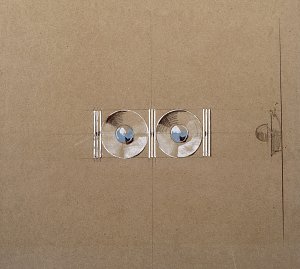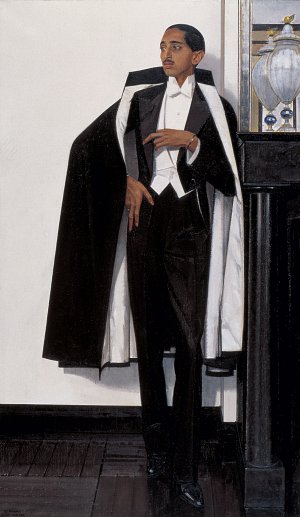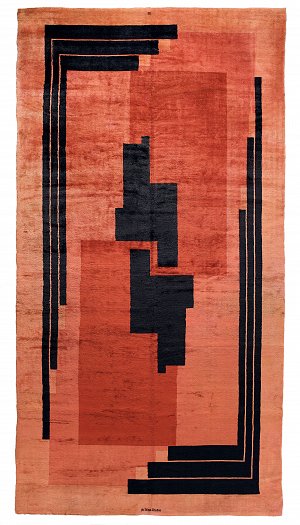Modern Maharaja, a patron of the arts in the 30s - YouTube

Eckart Muthesius, design for a wall lamp made by Max Kruger, c. 1930
© Adagp, Paris, 2019; Photo © Phillips Auctioneers Limited. Tous droits réservés
Born in 1908, Yashwant Rao Holkar II (1908-1961) spent the majority of his youth in the luxurious and stately conditions afforded to the princes of India. During the 1920s, Holkar II was sent to study at Oxford in England where a Frenchspeaking private tutor, Dr. Marcel Hardy, introduced him to the cultural milieu of European modern artists. Under the guidance of Dr. Hardy, Holkar II met two figures who would become instrumental in his artistic pursuits: the German modern architect Eckart Muthesius (1904-1989) and French artistic advisor and writer Henri-Pierre Roché (1879-1959), both of whom were closely linked to the avantgarde. Together, they visited England, Germany and France, exploring art fairs, museum exhibitions, galleries and artist’s workshops, rousing in Holkar II a passion for Modern Art.
Upon his father’s abdication in 1926, Holkar II acceded to the throne as Maharaja of Indore and became entitled to vast wealth and influence. In 1929, shortly after meeting the eminent French couturier and collector Jacques Doucet (1853-1929) in Paris and seeing his studio and collection, the Maharaja decided to erect a grand palace in his native India where he would combine luxury, comfort and modernity, embracing the features of the Modernist movement.

Eckart Muthesius, retouched exterior view of the Manik Bagh Palace c. 1933
© Collection Vera Muthesius / Adagp, Paris, 2019
Eckart Muthesius, the Maharaja’s good friend and mentor, was put in charge of
drawing up the blue print. This entailed transforming the foundations of a preexisting
building in order to construct a Modern private residence for the Maharaja and his wife, the Maharani Sanyogita Bai Devi (1914-1937). Designed with their daily needs in mind, the Manik Bagh Palace was decorated with fittings and furniture that glorified the most innovative materials of the period such as metal, synthetic leather and glass, while paying special attention to color within each room. Nearly twenty hand-selected interior designers furnished the rooms, now iconic of the Modern period.
Some of the most emblematic pieces include Transat armchairs by Irish designer
Eileen Gray (1878-1976); a pair of red synthetic leather armchairs with integrated lamps by Eckart Muthesius; beds in metal and glass by French designers Louis
Sognot (1892-1970) and Charlotte Alix (1892-1987) designed for the respective
bedrooms of the royal couple; and rugs by French painter and weaver Ivan Da Silva Bruhns (1881-1980) that covered the palace floors like vast abstract paintings.
-

Eckart Muthesius, pair of armchairs with integrated lighting 1931
© Adagp, Paris, 2019 Photo © Écl’art - Galerie Doria, Paris
-

Le Corbusier, Charlotte Perriand and Pierre Jeanneret, Reclining chaise longue, model B306, manufactured by Thonet c. 1931
© Adagp, Paris, 2019; © F.L.C./ Adagp, Paris, 2019; Photo © Sotheby’s / Art Digital Studio
The exhibition Moderne Maharajah, un mécène des années 1930 invites
visitors to discover the Maharaja’s innovative world, unerringly representative of Modernism and a central moment in the history of decorative arts. The exhibition begins by introducing us to the Maharaja of Indore and the Holkar Dynasty to which
he belonged, as well as to the friendships and relations that the Maharaja made over
the years from all corners of the globe and particularly, in relation to the construction
and design of the Manik Bagh Palace.

Bernard Boutet de Monvel S.A. The Maharaja of Indore (Western Dress), 1929
© Collection Al Thani / Adagp, Paris, 2019. Photo © Pascal Cadiou
The exhibition continues by highlighting other commissions given to Eckart Muthesius by the Maharaja including a furnished private train, an airplane and a caravan, as well as unrealized projects such as a riverboat and a summer palace, historically contextualizing the couple and their interests during the 1930s. Additionally, stunning Modernist portraits of the Maharaja and the Maharani by French painter and sculptor Bernard Boutet de Monvel (1881-1949) are
displayed alongside photographs of the couple taken by their good friend, American artist and photographer Man Ray (1890-1976), who captured the couple in the relaxed environment of the Manik Bagh palace.

Ivan da Silva Bruhns, rug for the Maharaja of Indore’s bedroom, c. 1930
© Adagp, Paris, 2019; Photo © Phillips Auctioneers Limited. Tous droits réservés
The Central Hall of the Musée des Arts Décoratifs will display previously unseen films by Eckart Muthesius, offering a glimpse of the Maharaja and his wife at home as well as overseeing traditional ceremonies throughout Indore.
The galleries along the Tuileries Gardens will house the Modern furnishings that
played such a prominent role in the Maharaja’s collection, recreating his office, the royal couple’s respective bedrooms, and the library.
His activities as a collector are also the focus of a section devoted to the salons and exhibitions of the 1920s and 1930s, namely the Salon of the Union des Artistes Modernes and the Salon d’Automne in Paris, where the Maharaja made numerous acquisitions of furniture, objects and lighting, most notably from the Maison Desny. Important commissions for the dining room will also be displayed, including china by French ceramicist Jean Luce (1895-1964) and silverware by French silversmith Jean Puiforcat (1897-1945), who also designed the monogram of the Maharaja and Maharani displayed over the entrance to the Manik Bagh Palace.
The exhibition also evokes the Maharaja’s marked interest in the great jewelry
houses of the time such as Van Cleef & Arpels, Harry Winston and Chaumet, all of whom created majestic pieces for the Maharani. Preparatory designs by Romanian sculptor Constantin Brancusi (1876-1957), including drawings for a proposed Meditation Temple in Indore and a plaster model of Bird in Space, of which the prince commissioned three versions between 1933 and 1936, are also on display.

Staircase of the grand hall and suspended ceiling light by Eckart Muthesius, c. 1933
© Collection Vera Muthesius / Adagp, Paris, 2019
Moderne Maharajah, un mécène des années 1930 offers a unique opportunity to view a flawlessly curated collection of art and design, amassed by a man who spared no expense in pursuing his passion for all things Modern. Reunited for the first time since these 500 objects left the Manik Bagh Palace, and elevated by never-before-seen archival materials, the Moderne Maharaja pays homage to one of the most emblematic figures of the 1920’s and 1930’s and
whose patronage of the Modern arts allowed a movement to flourish.

Entrance hall of the Manik Bagh Palace, c. 1933
© Collection Vera Muthesius / Adagp, Paris, 2019